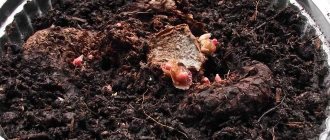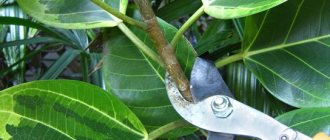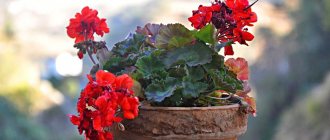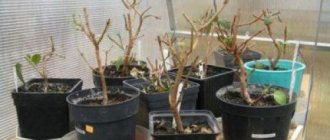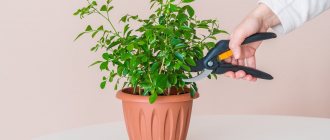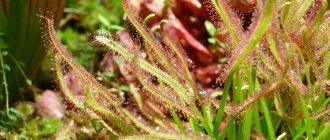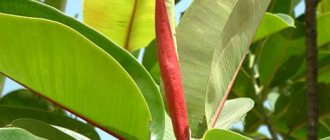How to care after the procedure?
To prevent infection from entering the wound, the sections are treated with crushed charcoal or activated carbon and ash. Sometimes the cut sites are covered with woven bandages for several days. After pruning, the plant needs a short period of rest
. The pot with begonia is shaded - placed in a shaded part of the house or protected with a curtain. The quantity and frequency of watering is reduced.
The watering regime is gradually returned after the side shoots begin to grow. After the irrigation regime is restored, the plant needs feeding. It is not recommended to do this for the winter; it is better to feed the begonia in spring and summer. You should not overfeed, since the introduction of additional nutrients changes the pH (acidity) of the soil. Nitrogen-containing fertilizers are best.
Pruning is a necessary procedure for the formation of a healthy and beautiful bush.
. There is nothing complicated in the process itself; even a novice gardener can handle it. With a competent approach to pruning and pinching, taking into account the variety and time of year, you can get a magnificent plant that will delight the eye for many years.
If you find an error, please select a piece of text and press Ctrl+Enter
.
Begonia is a wonderful plant that can be grown at home, on the balcony and in the garden. Many novice gardeners do not know how to prune begonias
- a procedure without which it is impossible to grow a flower.
Why do you prune begonias?
As soon as begonia appears in your home, you need to start pinching and pruning. Why are these procedures performed?
- to form the crown of a young plant;
- improving begonia flowering;
- maintaining the correct proportions between the root system and crown;
- rejuvenation and maintaining the aesthetic appearance of the bush.
How to prune? How to prune begonia correctly?
Begonias grow quickly, experienced flower growers know that the stems of the plant quickly stretch, and if they are not trimmed in a timely manner, the leaves will become smaller, flowering will stop, and the lush attractive appearance will disappear.
The first pruning is carried out when the plant stems reach 7-8 cm; the bush can be given any shape (standard, bush, pyramidal, spherical), it depends on the preferences of the owner.
Once the plant is pruned, reduce watering until active growth begins. When the side shoots grow to 12 cm, their tops are trimmed. This procedure will help awaken the lateral kidneys. This is how a young begonia bush is formed; in the future, you need to carefully monitor the condition of the plant, remove loose or dried branches and leaves, shoots directed into the begonia.
If you still haven’t noticed, the plant has grown a lot and has become unattractive, then you can rejuvenate it if you pinch off the lower shoots and the top. This method does not always help to restore the attractiveness of begonias; then it is easier to re-root.
Pruning is carried out only with a sharp knife; under no circumstances should you use scissors, which can seriously injure the begonia. To avoid rotting and speed up the healing process, the cut areas should be treated with wood ash or crushed coal.
Features of proper pruning of different varieties of begonia
Begonias of all varieties need careful care; it is important to promptly get rid of dry and damaged leaves, otherwise they can lead to plant disease. Proper pruning of begonias is carried out depending on the type of plant: the royal rex and all its hybrids do not need to be pruned at all, thick-trunked adults are shortened rarely and only when necessary, the tops of ampelous ones are regularly cut off, this stimulates the awakening and growth of lateral shoots
Gardeners prune bush begonias heavily, choosing places above the outer bud; usually pruning is carried out frequently; this variety of plant grows very quickly.
It is necessary to prune begonia correctly, as the shoots grow, to prevent strong stretching of the branches and a decrease in the exchange of leaves. As soon as you have purchased a begonia, try to immediately form a beautiful crown; in the future, it is enough to simply remove excess branches and leaves.
(7
rated, score:
7.57
out of 10)
Begonia is a plant that belongs to the Begonieceae family and decorates public gardens, parks and apartments. There are about 900 full-fledged species of this plant in the world. The homeland of begonias is Southeast Asia. The size of the plant can be from 5 cm to 3 m in length.
In this article you will learn some secrets of caring for beautiful flowering begonias at home.
Reproduction by dividing the tuber and bush
Tuberous begonia care and propagation are slightly different from other plant species. Plants that are at least 2 years old are suitable for dividing tubers. You should choose healthy planting material with 2-5 buds.
Reproduction technology:
- Divide the tuber into parts.
- Treat the cuts with wood ash.
- Plant in the soil so that only the buds remain on the surface.
- Cover the container with film.
As soon as the first leaves appear, the shelter should be removed.
Similarly, you can use the method of dividing a bush. At the beginning of spring, you need to cut the bush so that each individual element contains a bud and a sprout. Treat the cut with wood ash. Place the roots in pots with prepared soil.
Why do you need to form a crown of indoor flowers?
Among the main goals of plant formation are:
- Limiting the space that the plant occupies;
- Giving the desired shape and attractive appearance;
- Removing ugly, weak shoots;
- Providing access to light and air to the flower;
- Stimulating flowering by reducing the number of shoots and branches that deplete the plant;
- Ensuring equal development of all shoots, uniform distribution of nutrients between them;
- Stimulating the development of shoots that will produce flower buds.
The main techniques for forming the crown of indoor plants are pruning, pinching, pinching and tying.
Growing ampelous begonia from seeds
Before sowing the seeds, the soil is well moistened, the seeds are distributed over the surface of the soil, covered with film and kept at a temperature of +25°C. When the first shoots appear (after 10-25 days), you need to make sure that they are not exposed to sunlight, place the container in a tray with water, and lower the temperature to 20°C. Seedlings should be under light for 12-13 hours a day.
After 50-60 days, the plants are planted; this can be done in separate cups. Then the seedlings are provided with sufficient lighting, they need to be rearranged from time to time and fed with fertilizers every 14 days. After 20 weeks you can plant it in a permanent place.
Features for some types: how to form?
- Red leaf begonia. The purpose of pruning is to obtain planting material. It is not recommended to form its crown.
- Elatior, a beautiful flowering hybrid. After the flowering period, this species loses its attractiveness; this is corrected by pruning. To do this, leave stumps 5-7 cm tall. New shoots that grow are pinched to form a bush with dense foliage.
- Terry begonia, ever-blooming variety. It grows intensively, the stems quickly stretch, so regular pruning is required. Thanks to this, the plant actively blooms and looks impressive.
- Coral begonia, bush variety. A special feature of caring for this species is its formation in the form of a bush. Therefore, to form side stems, it must be pinched periodically.
- Masona, decorative deciduous variety. In order for this type of flower to begin to bush, it needs to be pinched, setting the desired shape.
- Hogweed. During growth, the plant becomes longer and the lower part of the stem becomes bare, so the elongated shoots are cut off, leaving small stumps, from which new foliage will later appear.
- Cleopatra, decorative flowering plant. This species is pruned in the spring or when replanting, leaving about 5 cm of stem.
- Tiger begonia, ampelous tuberous variety. When transplanting, the leaves are cut off for successful rooting. A young plant up to 4 years old is replanted every spring.
- Spotted begonia, decorative deciduous variety. The top of the species is pinched to form a lush crown. To increase the size of the leaves, the buds are cut off. Old plants are rejuvenated by pruning every 3-4 years.
- Collared begonia, ornamental flowering plant. Trim it to form a beautiful crown. The top shoots are removed to allow the side stems to grow. This is usually done in the spring.
How to rejuvenate begonia with elongated leafless shoots
The only way to return the plant to its lush shape is to trim those branches that have become “naked.” In bush begonias, stems that are too long and thin are cut off with a sharp knife. This will form a rounded bush and stimulate the formation of side shoots.
By the way, you can avoid loss of decorativeness by doing shaping in the early stages. The top growth point of young bushes should be removed when they reach a height of 10-15 cm. In the future, periodically pinch off the tops of branches that do not want to branch. You also need to completely cut out the stems growing inside the bush.
Ampelous begonias must be trimmed periodically, removing the tops of young shoots. Then they will not need rejuvenation.
How to prune correctly at home if the plant is stretched?
The specifics of pruning begonias include four points:
- Start of trimming. The formation of begonia begins at an early stage of growth. A plant 6-7 cm long needs to be cut off at the top. This will lead to intensive growth of side shoots.
- Reduce watering. After the first pruning, the frequency of watering is reduced until the active development of the flower begins.
- Further pruning. When the side shoots grow to 10 cm, their tops are cut off. In this case, the pruning should be above the bud located on the outside of the shoot.
- End of trimming. This completes the formation of the young begonia. After this, you can trim the elongated shoots to regulate the shape of the plant, cut off the dried stems and those growing inside the bush.
Is it possible to carry out the procedure?
An unpruned neglected plant is characterized by:
- elongated thin stems;
- small leaves;
- poor flowering.
Pruning a plant helps:
- The formation of a crown of the desired shape, a well-groomed appearance of the bush.
- Increased flowering.
- Preservation of the proportions of the root system and the above-ground part of the begonia.
- Disease prevention - dry foliage and damaged stems that provoke flower diseases are pruned.
- Rejuvenate the flower and stimulate the growth of young shoots.
Tools
Begonias are pruned with pruning shears or garden shears. Tool requirements:
- the tool must be sharp; a dull one can damage the flower;
- the instrument is disinfected with alcohol to avoid suppuration of the cut site;
- the instrument must be clean and dry;
- Scissors used in everyday life should not be used.
What to do after flowering?
The aerial part of a faded tuberous begonia is completely cut off, leaving a small stump. This promotes the absorption of the maximum amount of nutrients from the soil. Or they dig up the tubers, dry them and store them in a cold place until the new season.
After flowering, bush begonia needs to remove flower stems and trim shoots.
Preparing for winter
Winter is the plant's dormant time. Preparation for this period takes place in the fall. It consists of reducing the amount of watering, moving the flower pot to a dark, cool place up to +15 degrees (basement, loggia) and pruning.
Begonias need to be pruned in October. To do this, remove the upper part, leaving a stump of 2 cm above the ground. Six months of rest is enough to recover before the next season.
There is also an opinion that pruning a plant before winter does not make sense.
But it has been noticed that if you do not prune a flower for the winter, it will be exhausted, bloom sparingly, or flowering will not occur at all, the buds will wither without opening. In February-March, the plant begins to wake up, and already in the summer it pleases with overgrown foliage and abundant flowering.
Do I need to pinch?
Pinch out in spring or autumn, before budding or after flowering.
The procedure consists of pinching off the top shoot of the main stem by 1-2 cm. After a couple of weeks, the bush will begin to grow actively, side stems will form, and the plant will become bushier.
Pinching differs from pruning in that only a small portion of the top of the stem is removed. Pinch with your hands.
Video about pruning and pinching begonias:
Pruning begonias for the winter
On the question of the need to prune begonias for the winter, flower growers cannot come to a common opinion. Some consider this procedure pointless, others insist on carrying it out. They are unanimous only in relation to tuberous varieties, which are cut off radically. These species require a mandatory rest period to recover and prepare for the next season. Otherwise, the tubers, which have not accumulated enough nutrients over the winter, will weaken and will not produce full flowering. And the very appearance of the bush will be extremely untidy.
The best time for pre-winter pruning of begonias is considered to be October, when the flowers are already fading and the foliage turns yellow and dries completely on its own. Mow down the entire ground mass, leaving only short stumps no more than 1.5-2 cm high. Then the plant is moved to a cooler (+13...+15 °C) and darkened place. Watering is reduced to a minimum, making sure that the substrate lump is only barely moist.
Begonia tubers can be removed from the pot, dried a little and stored in the refrigerator all winter. In spring, the plant is again planted in a container.
Anti-aging pruning
Some plants, especially those that grow slowly, can do without rejuvenation. But most indoor green “friends” still have to be pruned for this purpose. For example, these are flowers that quickly stretch out when there is a lack of light. Plants with long shoots especially need this type of pruning.
Over time, due to lack of light, too high a temperature or insufficient air humidity, their leaves at the base dry out and fall off. And the flower takes on an unattractive appearance. These are, for example, tradescantia, balsam, passionflower, abutilon, pelargonium, dieffenbachia. Their lower part quickly becomes exposed, and the only way to maintain a well-groomed and attractive appearance is to trim them regularly and thoroughly.
Anti-aging pruning is best done in the spring before or shortly after the growth period, or in the fall, when the plant is dormant (you can read more about the life phases of indoor plants here).
Shoots are cut almost to the ground
It is important that there are 2-4 living buds left on the “stump”. Only 10-15% of the entire flower may remain
However, the more thorough the pruning, the more vigorously new shoots will grow. If it’s hard to decide to trim the entire plant at once, you can do it in 2 stages. First, half of the shoots are cut off. And when new ones grow from them, the remaining half is cut off.
After rejuvenating pruning, the flower needs feeding, because it will undergo intensive growth.
Watering at this time is slightly reduced, because the shortened upper part does not need a lot of moisture. It is better to place the pot in partial shade, away from direct rays of the sun. After such pruning, the flower produces many healthy, strong shoots and acquires a luxurious appearance.
Description
This plant was found and described at the end of the 17th century. The Begoniaceae family is distributed in the Asian, South American and African tropics.
Experts have developed many varieties of hanging begonia:
- Girl (Girl) is a spreading bush with long (about 28 cm), hanging shoots. The leaf apparatus is toothed, pointed in shape. It blooms in a soft pink color, the flower diameter is about 2.5 cm, and is propagated by cuttings. Used for vertical gardening and hanging vases;
- Kati is a spreading bush with hanging, weak shoots (about 21-28 cm long). Blooms yellow, flower diameter is over 3.0 cm, looks great in a hanging vase;
- Kristy is a spreading bush with hanging, weak, long (about 31-38 cm) shoots. Blooms white, flower diameter is over 3.5 cm, looks great in a hanging vase;
- Roxana is a compact bush with strong, long (about 31-38 cm) shoots. Blooms orange, flower diameter is over 4.0 cm, looks great in a vase.
Ampelous begonia has the ability to neutralize negative energy, stimulate human activity, bring harmony, and improve mood.
If the plant develops and grows quickly, prosperity will soon come, and if it suddenly begins to bloom, the family will be replenished.
What problems might arise?
When growing begonias from cuttings, some problems may arise.
If roots don't appear
For them to arise, the following rules must be observed. It is worth refreshing the cut on the cutting, which is in the liquid, and pouring clean water. You can also add Kornevin to the liquid. It is necessary to check the dryness of the soil; if the soil is dry, then you need to cover the cutting to obtain high humidity. It is necessary to periodically change the method of soaking cuttings in liquid to the method of rooting cuttings in the soil. You can't rush, you need to give the flower time.
If the flower does not develop
We need to inspect the plant. Due to poor care, diseases and pests can appear. Diseases can be cured with the help of special medications, but harmful insects must be removed yourself or use systemic insecticides. It happens that the flower is too filled with liquid. If the plant is lethargic, then you need to remove the soil from the pot to dry it. It is necessary to replace the soil and trim rotten roots. Then you need to put the begonia back in the container.
If the flower does not develop with the onset of winter, then it should be left until spring. In spring, begonia will continue to develop. In summer, the plant needs to be transplanted outside to make it healthier.
It is important that the room where the begonia will be planted is protected from winds, showers and hot sun. Thus, this flower is very easy to care for, it is easy to cut and grow.
If the cuttings cannot take root, then they need to be planted again.
For information on how to propagate begonia from cuttings, see below.
Humidity and watering
The plant requires high air humidity, so it is in winter that begonia suffers due to the dry microclimate in residential areas. You should not place pots of flowers near heating appliances. In addition, the air should be additionally humidified. But there is no need to spray begonia; dark spots from water may appear on the leaves. At this time, it is recommended to place the container with the plant in a tray with expanded clay, which must be regularly moistened.
Begonia should be watered with settled water. On hot days this should be done every day. In winter, begonias have a dormant period, so the need for water is minimal. How to determine that a plant needs watering? If the soil has dried out 1 cm deep, it’s time to water the flower. You need to water well, but do not allow the water to stagnate, so excess liquid must be removed from the pan. Tuberous species do without water in winter; they are kept in a special soil consisting of peat.
Transfer
For all types of begonias, including tuberous ones, acidified soils are preferred. Plants are undemanding to the composition of the soil; it can be easily prepared at home. Good drainage is a guarantee of flower health and active growth. It will be provided by a layer of medium-sized gravel, peat moss or regular sand placed at the bottom of the pot. Lay leaf soil on top; it should fill the container halfway. The remaining space is occupied by peat and black soil, mixed in equal proportions. Then all that remains is to plant the plant in the ground.
If the begonias become cramped in the pot, you need to change it to a more spacious one. It is better to do this in early spring
The flower is carefully removed, its roots are carefully cleaned of old soil and briefly dipped in a weak solution of potassium permanganate. After disinfection, carefully examine the root system of the plant.
If there are areas with signs of rot, they are removed.
After transplanting, which is stressful for the plants, begonias will need more attention and care. They need to be watered more often and thoroughly. You should not immediately place the flowerpot on a brightly lit windowsill; it is better for the flowers to stay in the shade for some time. They usually take root in a new pot within 1 month.
Begonia is one of those plants that can safely be called universal. Its cultivation is possible both outdoors in the garden and at home. It will decorate any window, balcony, veranda, front garden, steps in front of the house. The shapes and varieties of the plant are so diverse that even the most capricious gardener will find a variety that suits his taste. A special place in women's hearts belongs to the tuberous begonia.
It is difficult to find another flower that would combine whimsical sophistication and amazing unpretentiousness. It is worth giving indoor begonias just a little time and care, and they will definitely thank you with lush fragrant flowers or dense carved foliage, the beauty of which will not leave anyone indifferent.
Some interesting facts about begonia
The history of the name is connected with the name of Michel Begon, who traveled a lot and was interested in botany. Interestingly, the root tubers of the plant can be eaten; they have a citrus fruit flavor.
North Korea has made the begonia a national symbol, which is depicted on the country's coat of arms. In many countries there are legends associated with this flower. In China, you can hear a legend that says that begonia grew from the tears of a woman in love. In Belgium, during the flower festival, begonias are used to make paintings.
Recommendations regarding further care of begonia
Before wondering how to propagate begonia from leaves or cuttings, a novice gardener should definitely familiarize himself with some recommendations regarding plant care. Cuttings and cultivation of the crop require regular ventilation of the begonia, as well as moistening the soil with a spray bottle. With the appearance of the first shoots, it is necessary to gradually increase the ventilation time so that the begonia has adapted and become accustomed to the air.
If the night is relatively warm and cloudy, the window in the room where the cuttings are located can be opened. If you follow the advice of experienced gardeners, you can quickly transplant young shoots into separate containers. It is also worth noting that rooting begonias using leaves must be carried out in the second half of spring or early summer, but always at a temperature of no more than 30 degrees Celsius.
Suitable conditions are extremely important for begonias.
Begonia can very often be affected by diseases and pests such as spider mites and aphids. It is recommended to treat the crop and fight parasites with the help of an infusion prepared according to a recipe from garlic or onion peels, with which you need to periodically spray the plant. To avoid the reappearance of pests, begonia should be treated with wood ash, previously diluted in water.
Important! Young seedlings need to be additionally fed with mineral fertilizers, which include potassium and phosphorus. You can put a small amount of compost or peat on the garden bed
If all recommendations are carefully followed, growing and propagating begonias will certainly lead to the desired result, and a beautiful flowering plant will become a real pearl of a garden plot or living space.
Sources
- https://sadovnikam.ru/475885a-begoniya-razmnojenie-listom-v-domashnih-usloviyah
- https://7ogorod.ru/cvety/kak-razmnozaetsa-begonia.html
- https://ZnaySad.ru/komnatnye-rasteniya/begoniya-klubnevaya-razmnozhenie.html
- https://zen.yandex.ru/media/id/5acdc749a936f403513eae47/5b6bd44e2d39ed00aa0db6fb
- https://floplants.com/razmnozhenie/kak-razmnozhit-begoniyu-v-domashnix-usloviyax/
- https://osobnyachkom.ru/beauty-benefits/houseplants/kak-razmnozhit-begoniyu-cherenkami.html
- https://floradoma.net/flowering-plants/begonia/begoniya-razmnozhenie.html
- https://greensotka.ru/dekorativno-listvennye/begonia-razmnozenie.html
- https://o-rasteniyax.ru/kak-razmnozhit-begoniyu-v-domashnih-usloviyah-raznyimi-sposobami/
- https://stroy-podskazka.ru/begoniya/razmnozhenie-cherenkami/
Propagation by cuttings
This method is used most often because this way you can quickly get an adult plant. For propagation you need to take a cutting about 10 cm in size.
Breeding order:
- Remove the lower leaves and cut all the rest in half.
- Add river sand to the soil for begonias.
- Deepen the cuttings into the soil.
- Cover the top with film.
After a month, you should begin to accustom the plant to normal conditions. To do this, the film should be opened daily, each time increasing the ventilation time. Within a month, begonia planted in this way begins to bloom.
How to properly care after cutting?
After pruning, it is enough to follow basic rules of care.
The most favorable temperature range is from 13 to 22 degrees Celsius, but do not forget to maintain stable air humidity. The optimal level of air humidity is 60 percent. Since our begonia is a herbaceous species, the dormant state lasts from October to February.
To transfer the plant to this state, watering is reduced and wilted shoots are cut off. Some experts advise storing begonia tubers in the dark at a temperature of 10 to 12 degrees Celsius for up to two months. The best growth properties appear when the plant is in partial shade. Watering is carried out only after the top layer of soil has completely dried.
To provide the begonia with the necessary moisture, the pot should be placed on a tray with water, but so that the pot itself is not in the water, or placed on wet peat.
If the humidity level is too high, the begonia will rot, so do not overdo it. On hot summer days, the air around the begonia is sprayed, but so that water does not get on the leaves. The room in which the begonia is located must be ventilated periodically, but so that the plant itself is not exposed to a draft. Transplantation is performed only in cases of extreme necessity.
In conclusion, I would like to say that pruning and pinching begonias are very important procedures that will both increase the splendor and decorativeness of the begonia and extend its life. In addition, these procedures are so simple that any novice gardener who has never even approached begonias before can perform them.
The process itself will also be useful in the future, when pinching and trimming other plants, because in fact the technology is the same.
If you find an error, please select a piece of text and press Ctrl+Enter.
What to do next with the plant?
What to do with the plant depends on the type of root system (you can learn about the types of begonia and its root systems here).
Tuberous
If the begonia is tuberous, the roots are dug up to save them until next year. Rules:
- When the above-ground part is dry, the tubers are pulled out of the pot.
- Remove all dried roots.
- Inspect for rotting. If there are rotten roots, they are carefully trimmed with a sharp knife. Sprinkle with charcoal powder and dry.
For storage, the tubers are placed in an airtight container, lightly sprinkled with sawdust or damp sand. Planting material is kept in a cold place until spring.
Watch a video about what to do with tuberous begonia during the dormant period:
Not tuberous
In begonias with a regular root system, the flowering period lasts until spring. It is recommended to give plants rest.
Note! As soon as flowering begins to decline, the conditions for keeping the crop are changed from November-December.
To do this, take the following actions:
- Stop feeding.
- Reduce watering. The soil is moistened when it becomes completely dry.
- Trim the plant. Unnecessary shoots are removed, the main ones are trimmed, leaving 12-15 cm. The cut areas are treated with coal powder.
Begonias need to be provided with a normal level of humidity. You can spray the air around the plant or install a tray with water. Pebbles are poured into the bottom of the container and a pot is placed on top.
The flower is taken to a dark place. Bright light promotes resumption of flowering, and buds are formed during short daylight hours. The temperature during this period is reduced to + 10-15 degrees.
From the video you will learn what to do if the non-tuberous begonia has faded:
Follow-up care at home
Both pinching and pruning are stressful for the plant. Therefore, after these manipulations they need special care:
It is important to place the pots in a very bright place. Bright lighting will increase metabolism in the leaves and also prevent new shoots from stretching out.
The lack of the necessary lighting will negate the meaning of the pruning and pinching, since the plant will again be elongated with a small number of flowers. The temperature should be within +17- +23 degrees Celsius. Watering should be moderate. The plant has lost a large amount of greenery, so it needs less moisture. Do not overwater the flower, the roots may rot. Make sure there is no stagnation of water in the pot. Drain any leaked water from the pan. Water should be used at room temperature. After spring pruning, you need to wait 10 days. Then you can start feeding. Feed once every 2 weeks with fertilizers containing phosphorus and nitrogen. They are needed for the formation of foliage. As the flowering phase approaches, fertilizers need to be changed to ones containing potassium. You can find out more about how to feed pelargonium here.
If you remember your grandmother’s house, there were always tall pelargoniums on its window sills that spanned the entire window. Naturally, in the past no special attention was paid to flower care. But today, when there is unlimited access to Internet resources and literature, where it is explained in detail and step by step how and when everything needs to be done, it would be a sin to neglect this opportunity. Study, grow, follow simple care rules and enjoy healthy and beautiful pelargoniums.
You can learn more about growing pelargonium and caring for it here.
For those interested in pelargoniums, other articles on our website about the composition of soil for a flower, about the lack of flowering, as well as about replanting and rooting may be useful.
Lighting and temperature conditions
Begonia is one of the most popular indoor plants, combining excellent decorative qualities and ease of cultivation. Even novice gardeners can cope with caring for begonias in a pot.
The plant requires good lighting, but direct sunlight can burn the leaves. It is best to place the begonia on a window facing east or west. In winter, the plant should be moved to the south side. It must be remembered that begonias require more light during flowering. Decorative deciduous species of this plant are less demanding on the level of illumination.
The indoor begonia flower feels good at a temperature of 20-25°C in summer; in winter, 18-23°C is sufficient. Begonia is a heat-loving plant, so temperatures below 15°C lead to the death of the green pet.
You should pay attention to this feature: begonia does not tolerate proximity to other indoor plants, so it is best to place it on a separate windowsill.
What to do to make the bush grow thicker?
On a note. In order for geranium to grow into a lush bush, its apical bud on the main shoot above the stem node must be pinched.
This stimulates the growth of lateral buds on the lower nodes of the stem. After this event, the seedlings will slow down their growth, but will begin to gain strength. The geranium will eventually take on a beautiful spherical shape due to the appearance of many side stems.
How to prevent the flower from stretching too much upward?
To prevent geraniums from stretching out, pinching should be done at the most important upper point of stem formation. If after this procedure the shoots begin to grow again from the upper axils of the leaves, they must be removed, then allowed to grow a little and pinched back again. During this time, the buds are removed so that the flower devotes all its strength only to the growth of side shoots.
What to do for lush flowering?
Only young shoots bloom in geraniums. Therefore, in order for it to develop quickly and bloom luxuriantly, young shoots must be pinched after the formation of the first 4-5 pairs of leaves. As a result, the remaining strong shoots will begin to actively grow and develop, turning into a lush crown with many flowers.
Pinching begonias
The fundamental difference between pinching and pruning is that only a small part (no more than 2 cm) of the apical shoot is removed (pinched). This manipulation awakens spare (dormant) lateral buds and stimulates branching, which allows you to achieve the required crown shape. The procedure is especially important for very young small plants, when the tops of young branches are simply pinched off with your fingers. It is better to do this in early spring before budding or in the fall after the flowers have withered.
Reproduction of begonias at home
Now it's time to talk about how to propagate begonia at home. The plant can be propagated using leaf cuttings, stems and dividing the bush.
Leaf cuttings
This method is used specifically in indoor floriculture. Cuttings are parts of a plant that are used in vegetative propagation. This propagation can be done using root, stem and leaf cuttings.
Reproduction can be carried out in several ways: a whole leaf with a petiole, a whole leaf without a petiole, or part of a leaf blade.
Propagation by a whole leaf with a petiole is suitable for some types of begonia. The length of the petiole depends on the rooting environment of the cutting. If you root in water, the petiole should be 3-4 cm long, if in the ground - 1-1.5 cm.
Reproduction by a whole leaf without a petiole is suitable for the “rex” begonia species. To do this, cuts are made on the thick veins of the begonia leaf and placed horizontally on the ground with the underside. After this, the leaves are pinned down, and after some time new shoots form in the cut areas, which can be grown.
Did you know?
Begonia began to be used for decorative purposes in 1890.
Propagation by part of the leaf blade is suitable for royal begonia and Mason begonia. A part of the leaf at the base, 4-5 cm wide, is cut off from the plant. Plant vertically 1-1.5 cm deep and install small supports. In this case, the begonia leaf should not come into contact with the ground.
To obtain a full-fledged shoot from a leaf cutting, it is necessary to maintain favorable conditions for rooting. The leaf must be plucked from a healthy plant. Old leaves are not suitable, as they are not capable of regeneration and quickly wither. Special requirements for caring for cuttings are humidity, lighting and temperature.
While the cuttings do not have roots, they will not be able to absorb water, so it is necessary to reduce the evaporation process.
Lighting should be diffused, as direct rays cause overheating and burns. The optimal temperature is 20-25°C.
A soilless substrate is used as soil. To do this, sand and peat are mixed in equal parts. Peat prevents the development of pathogenic fungi. Pure Vermiculite may also be suitable. It not only absorbs excess moisture, but also gives it back to the plant as needed.
Did you know?
The smell of begonia flowers helps cleanse the bronchi and is also an excellent natural filter for people with nicotine addiction.
Many florists are wondering how to fertilize begonia after propagation. Our answer is that the plant should not be fertilized at all at first.
With this method of propagation, you should not use chemicals, as they do not give the expected effect in the form of rapid root formation, and this can also inhibit the appearance of new shoots.
Plant nutrition
Indoor begonia flower needs feeding. Flower growers recommend fertilizing with complex liquid fertilizers once every 2 weeks. It should be remembered that deciduous species require nitrogen fertilizers. In the case when the begonia is blooming, care at home requires feeding with phosphate fertilizers. There is no need to feed in winter. The exception is ever-flowering species.
Flower growers use homemade compounds to fertilize this plant.
Recipe for fertilizer with yeast:
- Take 1 g of yeast, dilute it in 1 liter of warm water.
- Add 1 teaspoon of sugar.
- Let the mixture brew for at least 3 hours.
For fertilizer, dilute the liquid with water in a ratio of 1:5. This fertilizer should be used 5 times a year.
It is useful to feed begonia with sugar. To do this, dissolve 1 teaspoon of granulated sugar in 1 liter of water. You can water with this fertilizer no more than once a month.
Used tea leaves can also be used to fertilize flowers. Dry it first and mix it with soil during replanting in the following proportion: 1 part dry tea leaves and 3 parts soil.
Wood ash is actively used in indoor floriculture.
Fertilizer recipe:
- Dilute 3 tablespoons of ash in 1 liter of water.
- Leave for a week.
You can water with this mixture once every 2 weeks. Wood ash should be added when transplanting into the soil.
In flower shops you can buy fertilizers for begonias: “Kemira Lux”, “Good Power”, “Bona Forte”, “Mister Color”. Plants should not be overfed.
Rules for removing stems and shoots, when and how to do it?
Forming a crown for lush flowering
Pruning is necessary to maintain and improve the decorative appearance of plants. In fact, there are four main features when pruning begonias:
- Start of trimming.
This process must begin at the young flower stage. As soon as the small plant reaches a length of 6-7 centimeters, the top is cut off with scissors. Thanks to this simple procedure, begonias stimulate the growth of side shoots. - Reduce watering. After the first pruning, the amount of watering is reduced. This is done to increase the growth rate of begonia.
- Further pruning.
The next pruning is carried out after the length of the side stems reaches 10 centimeters. Shortening must take place above the bud, which is located on the outside of the stem. - End of trimming. Further, the shortening procedure can be carried out only to remove the most overgrown stems, or those that have dried out altogether. This procedure can also be carried out to maintain a specific shape.
In what cases is it performed?
Pruning is performed in the following situations:
- in decorative-leaved begonias, flower-bearing shoots are cut off;
- when dry or damaged leaves or shoots appear, this is done to avoid the appearance of diseases;
- in young plants to obtain decorative properties;
- pruning before winter.
When to prune plants for winter?
Flower growers often ask themselves a similar question. It is necessary to prune only tuberous begonias for the winter; all others are pruned at the request of the grower.
Attention! The optimal time for circumcision is October. With proper pruning, the active development of side shoots begins, which will greatly increase the splendor of the begonia itself.
How and when to pinch?
The pinning procedure is carried out in the fall, or in the spring, or, to put it correctly, either before flowering or after it. Now about the process itself, which is actually very simple. On the main stem you need to find the top growing point and pinch it off 1-2 centimeters. With proper pinching, active growth of side shoots should begin within 2-3 weeks. Also, this procedure should be carried out only in cases where it is not possible to prune the begonia.
If your begonia has ceased to please you with its blooming and beautiful appearance, then you need to familiarize yourself with our materials that will help solve such problems with your pet:
- leaves curl, dry out and turn yellow;
- blooming begonia refuses to bloom;
- leaves and flowers dry around the edges;
- buds fall.
Diseases and pests: treatment methods
If the plant is properly cared for, it will not be damaged by diseases or pests. But sometimes ampelous begonia exhibits signs of the following diseases:
- bacterial spotting - small watery spots form on the bottom of the leaf, later they turn brown. Plants need to be treated with a 0.5% suspension of copper oxychloride and repeated after 2 weeks. Affected bushes must be destroyed and the soil disinfected;
- gray rot - spots with a gray coating form on the plant, then in their place wet rot of a brown hue forms. The bushes need to be treated with fungicide solutions.
Begonia can be damaged by the following insects:
- soft scale insect - sucks juices from the plant, thereby causing deformation of the leaf apparatus. Growth and flowering deteriorate. The bushes are treated with insecticide solutions;
- greenhouse aphids - insects damage the plant and suck out the juices. The pest can also be a carrier of viruses. It is necessary to treat the bush with an insecticide solution.
Violation of the terms of the rest period
Like every plant, begonia needs a period of rest, during which it will rest before the next flowering. If it was not there at all or the begonia woke up ahead of schedule, it will not have enough strength to bloom again. We need help and set a rest schedule. With abundant flowering in winter, the summer three months are left for rest. With the arrival of summer, move the pot to a cool place in the shade with a temperature of no more than 17 degrees and reduce watering. Also reduce daylight hours to 7 hours and cover the top of the begonia after this time has expired.
Bring the flower out of hibernation also gradually - increase the length of daylight hours and watering, and raise the temperature.
Incorrect identification of plant type and too “young” age
As already mentioned, begonias are flowering and decorative. If everything is clear with flowering varieties, then decorative begonias will delight the eye only with unusual leaves. Deciduous varieties are also very beautiful, but if a begonia of a decorative type is included in the collection of flowers, expecting it to bloom is a useless task.
Experienced flower growers have long noticed that begonia blooms on its own only after at least 5 rings have formed on the main stem. When buying a young small plant that already has inflorescences, you can suspect that flowering is caused artificially by introducing special stimulating drugs. This means that it will be short and will not happen again until the begonia reaches the required age.
Why doesn't begonia bloom?
When answering the question why begonia does not bloom, it is worth considering the main reasons:
- improper lighting, which is not enough for the flower to carry out the process of photosynthesis;
- unsuitable soil (correct soil is slightly acidic, loose and nutritious);
- incorrect transplantation;
- insufficient amount of fertilizer;
- too dry indoor air or climatic influences, such as periods of drought;
- exposure to microorganisms that harm the root system or foliage;
- insufficient watering (this reason is the most important, because plant roots are most susceptible to moisture and its level should always be sufficient).
What kind of houseplant is this?
Begonia is the name of a genus of plants from the family of the same name. It can be herbaceous, semi- or shrubby. All representatives of the genus have asymmetrical leaves with a strongly indented leaf blade. It transforms during the flowering period. After pollination, buds of different colors and shades open on the flower stalks.
Begonias were first talked about in Europe at the end of the seventeenth century. Then scientists unexpectedly came across evergreen begonia in the New World, and a little later - royal begonia. A tuberous plant was discovered in the jungles of South America.
What to do if begonia does not bloom with double flowers
The double flower is truly beautiful and unique, which is a distinctive feature of begonia. But it happens that instead of the expected flower, the simplest ones grow. This problem is especially common in tuberous plants. There are several main reasons why this may be due:
- the tuber is insufficiently strong, especially for young plants blooming for the first time. This is due to insufficient rest period for the plant and improper propagation.
- lack of strength in the plant itself due to illiterate care.
- One should not exclude such a sign as a production error, especially for those seeds that were purchased in a store. Therefore, it is better to purchase the plant itself.
Note! It is worth reconsidering the care and waiting for the next flowering period, perhaps the begonia will gain strength and produce flowers with the desired properties.
